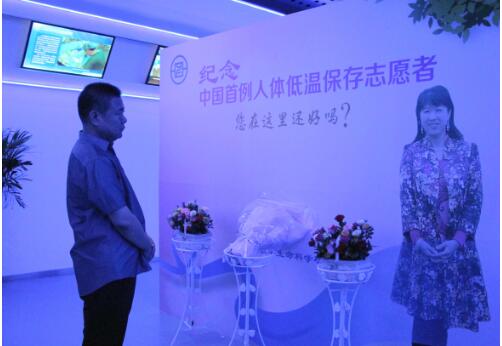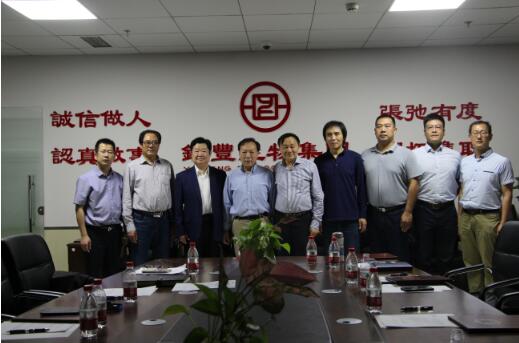After a year of freezing, how is Ms. Zhan in here?——In commemoration of the volunteer for China's first human cryopreser
On the morning of May 13, 2018, a small but high-profile commemorative event was held in low-key at the Shandong Yinfeng Life Science Research Institute - in memory of volunteer, Zhan Wenlian for China's first human cryopreservation case. The dozens participants in the event included volunteers' families, experts in well-known medical institutions or medical schools in Shandong Province, legal scholars, supporters of human cryopreservation, core members of the Yinfeng Life Sciences Research Institute, and some media reporters.
In May 2017, the Shandong Yinfeng Life Science Research Institute completed the first cryopreservation of the human body in China. It has been a whole year until today. In order to express the commemoration and respect for Ms. Zhan, in the hall of the Cryogenic Medical Research Center of the Yinfeng Research Institute, Ms. Zhan Wenlian’s favorite music is played -- “All I cared about is you”. Her husband Gui Junmin had a bouquet of yellow rose lay in front of his wife's huge picture, staring at her photos with affection.

At the event, Mr. Qu Tingyu, Executive Director of the Yinfeng Life Science Research Institute, briefed family members, experts, and supporters on the preservation of the past year. He mentioned that the No. 1 tank of Ms. Zhan was in good operation condition. In addition to the automatic data recorder of the liquid nitrogen tank, the Yinfeng Life Science Research Institute conducted daily inspections and recorded data such as temperature and liquid level to ensure the height of liquid nitrogen in tank can be maintained between 1.8-2.5m. During the holidays, even if the liquid nitrogen tank can achieve automatic replenishment and alarm, they still insist the time interval for manual inspection should not exceed 48 hours. In the past year, liquid nitrogen was supplemented for an average of 10 days, and the estimated consumption of liquid nitrogen per day was about 40 liters, which was lower than the original predicted data. This proves that the liquid nitrogen storage tank that was independently developed by Yinfeng Life Science Research Institute has a good low consumption performance.

Aaron Drake, a cryopreservation expert from the United States, represented Yinfeng Research Institute of Life Sciences to introduce the efforts were made in the past year to strengthen international communication, improve cryogenic preservation equipment, develop surgical monitoring systems, and supplement team.
Later, experts from various fields in Shandong Province discussed the medical significance, clinical application, law, ethics, and public welfare publicity of Yinfeng’s life science research plan, and announced the establishment of Shandong Yinfeng Life Science Research Institute’s ethics. The committee officially launched the Yinfeng Life Extension Research Program.
Liu Shuwei, professor of anatomy at Qilu Medical College, Shandong University, said: “At first, I was suspected Yinfeng Life Extension Research Project. But now, it seems that this research is worth to be carried out. For example, at what temperature it is possible to preserve the activity of the tissue better and to recover better in the future, these need to be verified through continuous experiments.”
Sun Wenyu, director of the Department of Cardiac Surgery at the Qilu Hospital of Shandong University (Qingdao District), also believes that, from a technical perspective, cryopreservation of tissues and organs is with great significance for clinical medicine. For example, the cryopreservation of the skin is a good guarantee for the treatment of burned patients. The study of cryopreservation for organs such as the heart and liver is even more necessary, which is essential for the continuation of patients' lives.
Wang Yongjun, Director of the Shandong Red Cross Business Development Department, said: "The Shandong Red Cross Society strongly supports the cryogenic preservation research carried out by the Yinfeng Research Institute and hopes to promote the development of this undertaking, promote the advancement of medical technology, and benefit more patients."
According to Sang Benqian, a law professor teaches in Ocean University of China, at present, China has no legislation on cryopreservation of human bodies. However, this exploration itself is still pioneering. It is recommended that relevant legislation should be accelerated to provide legal protection for scientific research.
The Yinfeng Life Continuation Research Program is not just the concept of “human cryonics” in media campaigns, but an innovative and challenging life sciences comprehensive research program, including genetic and scientific plans, cell banking and clinical transformation plans, and organ bank plans, even the artificial organ research program, the human cryopreservation research program is just one of them. As a research institution of Yinfeng Biotechnology Group, the Yinfeng Life Sciences Research Institute has targeted several major industries that are currently the most dynamic and very promising fields in biotechnology. As Jia Chunsheng, vice president of the Institute said that the technology of cryopreservation currently cannot guarantee that the cryopreserved human body will be able to resurrect in the future, but this is the courageous exploration of the life sciences and the ultimate dream in the field of cryogenic biomedicine. Yinfeng is engaged in research on cryopreservation of human body, and they hoped that it will be used clinically in the future to provide better services for patients with diseases through the preservation and resurrection of tissues and organs, and at the same time promote the donation of life resources that currently urgently needed to be progressed, like bodies, organs and hematopoietic stem cells in China, and promoted the development of science and technology.










